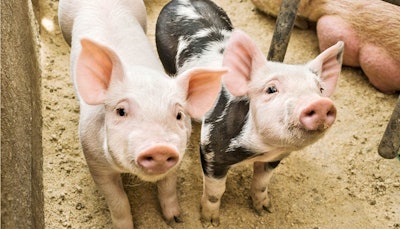
The nursery formulas presented here are for piglets right after birth until they exit the nursery at about 25 kg body weight, roughly double weights to get rounded U.S. pound-equivalent ranges. They are neither the most complex and expensive nor the least expensive and simple formulas possible. The aim is to present an average that would include all necessary ingredients and nutrients so feed professionals could adjust them to suit their needs.
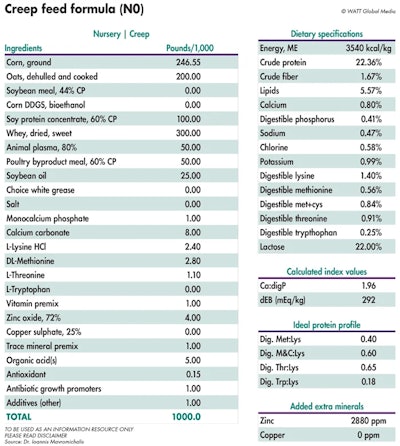
This formula is for piglets still nursing at the sow, that is, before weaning takes place at around 21 to 25 days of age. Some producers do not use this formula at all, whereas others prefer to use it right after weaning as a specialty feed for small-for-age piglets and other similarly underprivileged piglets. This formula is nearly identical with the next one (N1), which is usually called Phase 1 in the U.S., being the first feed offered post-weaning.
When a creep feed is offered, it is always advised not to change the feed after weaning for the first few days. With N0 and N1 formulas having more or less the same ingredients and comparable nutrient profiles, such provision is not necessary, unless feed form is different, i.e. pellets versus meal or crumbles.
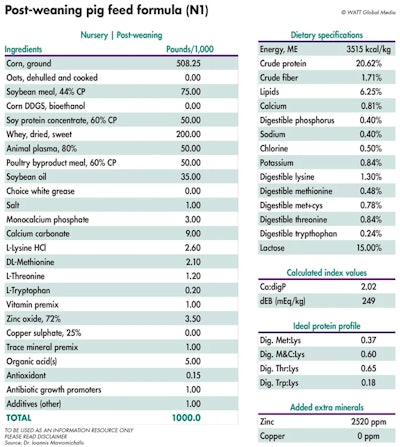
Downloadable PDF: Creep formula (N0)
Post-weaning formulas (N1, N2, N3)
These are the typical Phase 1, 2 and 3 formulas, respectively, offered at about 2, 5 and 20 kg per pig until piglets reach a body weight of 25 kg. This feed budget gives an average feed conversion ratio of 1.4 to 1.5, which is the universal target for this phase of production.
If the N0 formula is used, then some producers prefer to skip the N1 and wean pigs directly on N2, probably with some N0 being mixed with N2 during the first few days post-weaning. Others may use N1 for before and after weaning, eliminating the need for a special creep formula. The post-weaning formulas are almost always pelleted, whereas the creep feed is rather difficult to pellet due to high whey powder inclusion and low fiber concentration.
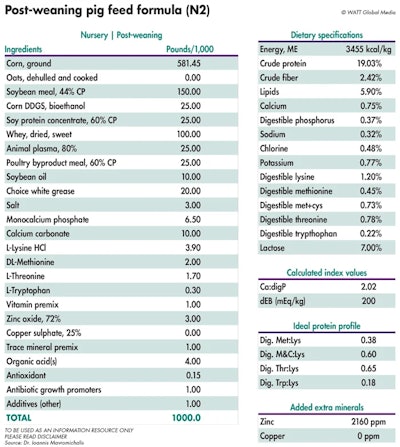
Downloadable PDF: Post-weaning pig feed formula (N1)
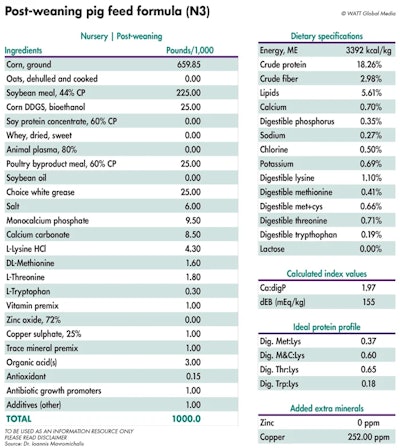
Downloadable PDF: Post-weaning pig feed formula (N2)
Piglet feed ingredients
We have used only common ingredients, avoiding alternatives and less expensive options. For example, only sweet dried whey was used as a source of lactose, although whey permeate or even dextrose and sucrose are widely used to replace part of the lactose in whey. Similarly, we have ignored skim milk powder as this is used only in a majority of specialty products. These and other practices are advanced exercises left at the discretion of qualified nutritionists who can evaluate and balance quality versus cost savings. Finally, it should be noted here that if sucrose is used in any formula, then such feed should not be given to piglets younger than five days of age.
Plasma is used on and off in the U.S., but we have included it here because it remains a widely accepted ingredient, unless there is a scare or other problem. If producers do not want animal plasma in their feeds, it can be replaced by another source of highly digestible proteins, such as fishmeal, soy protein concentrate, wheat gluten, but the contribution of bioactive compounds found in animal plasma will probably be lost.
There is a notable absence of fishmeal in these formulas, and this was done to illustrate the high cost of this raw material and the availability of good quality poultry byproduct meal that can replace it as a source of animal-derived proteins. Should quality be not guaranteed for poultry byproduct meal, then the extra cost for the more expensive fishmeal is warranted for these formulas. In fact, high-end products invariably contain high-quality fishmeal.
Finally, there is a small amount of dried distiller’s grains with solubles (DDGS) included to get pigs acclimated to this ingredient in anticipation of increasing amounts used in the growing-finishing feeds.
The use of soybean (vegetable) oil is preferred to animal fats for the early ages (N0 and N1) due to its higher digestibility in very young pigs. The transition is done quickly (N2 to N3) to get pigs accustomed to choice white grease (animal) that is being used widely at older ages (growing-finishing diets) as at digestibility is not an issue as pigs get older.
Feed additives
The additives of note used here are zinc oxide, copper sulfate and organic acids. Zinc oxide is still allowed at pharmacological levels in the U.S. and, as such, the full dosage of it is being used in the early feeds with diminishing amounts as age progresses.
In the last formula (N3), zinc oxide is replaced by copper sulfate to avoid zinc toxicity and because copper sulfate has been shown to work best in this age. Organic acids are used mainly to counteract the buffering capacity of zinc oxide. As such, they can be omitted or reduced in N3, although the recommendation remains to use them to improve digestibility and overall gut health. For the same reasons, some copper sulfate is often used in the first feed after N3, during the next production phase. In general, gentle transitions appear to work better than abrupt changes in ingredient and nutrient composition.
Other additives commonly used are antioxidants, which must be used at level as recommended by supplier; antibiotics (again, at levels recommended by supplier); and, of course, anything else that is deemed essential, such as flavors, phytase, mycotoxin binders, etc. These are all left outside these formulas to be decided locally according to specific needs. The inclusion rate of 1 kg per metric ton used for such additives are just placeholders to indicate their presence in the feed.
Nutrient specifications
As always, when it comes to nutrient specifications, the goal has been a gradual reduction in energy, protein and amino acids, along with all other nutrients as deemed appropriate. The protein levels used here are rather inappropriate for an antibiotic-free program, but they are optimum when antibiotics are used. The ratio of calcium to digestible phosphorus is kept near 2:1, whereas the dietary electrolyte balance diminishes with each successive formula. In fact, some nutritionists would argue that the potassium level is too low in N2 and N3, as a level between 0.75 and 1.0 is believed to be closer to actual requirements, but these are finer details outside the scope of this discussion.
The ideal protein profile is that recommended by the late D.H. Baker of the University of Illinois, and although many have argued against the actual figures — usually based on observation trials — few could argue about the validity of the research behind these numbers.
The inclusion level for the vitamin and trace mineral premixes are placeholders, again, as actual commercial products will have an indicated inclusion level. The actual levels for each individual vitamin and trace mineral are not included here as being a subject too advanced for this preliminary presentation. Nevertheless, they will be the matter of a future project presented here. For the purpose of this discussion, it suffices to mention that most nutritionists consider NRC (2012) requirements for vitamins and trace minerals as absolute minimums that require the addition of safety margins.
Finally, the levels of lactose may appear to some as being rather conservative, but in fact they are rather average, considering that some large operations start piglets at 10% or less lactose. And, although such lower levels are recommended in antibiotic-free diets (lactose is laxative), there is no real reason why lactose be lowered that much, except for short-term cost savings. High lactose levels invariably increase feed intake, even if animal plasma is used; the more so if animal plasma is not used.